
Caledonia
Anyone interested in a seemingly unlimited supply of quality golf must heed the siren’s call to Myrtle Beach, S.C.
The destination boasts more than 100 courses in its “Grand Strand” area, which extends north from Georgetown, through Myrtle Beach, and into North Carolina’s southern coast. Here golf is the main draw – or slice, as it were.
This golfers’ paradise boasts layouts designed by many of the world’s top architects. Coupled with its location on the Atlantic Coast and plenty of amenities and attractions, players can have almost as much fun off the course as on.
Myrtle Beach courses offer more varied choices than a golfer could imagine. Because the menu can be a bit daunting, we looked for venues that could act as a solid indoctrination to what the area has to offer. Then we decided that this first story should include four of the area’s benchmark courses, all highly ranked by the golfers that know this area best.
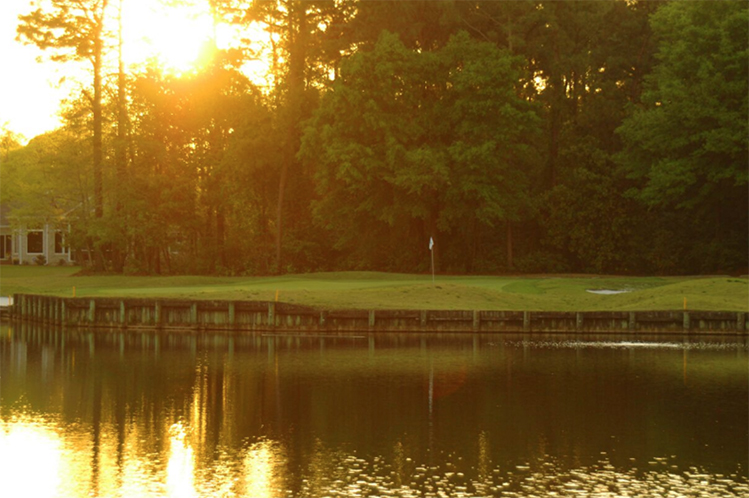
Pawleys Plantation
Caledonia, True Blue show two sides of Strantz’s personality
In the Grand Strand’s Lowcountry town of Pawleys Island, some 20 miles south of Myrtle Beach, the late golf architect Mike Strantz fashioned two memorable, though different, golf courses within earshot of each other.
With the sublime Caledonia Golf & Fish Club and True Blue Golf Club, Strantz, who succumbed to cancer in 2005 at age 50, cemented a legacy in golf architecture that ended way too soon.
Play Caledonia and True Blue on the same day if you can and you’ll learn first-hand about the beauty of Strantz’s hallmarks: undulating greens, well-positioned and diabolical bunkers, and forced carries that reward or punish risk-takers. Then play them again and revel in his subtle touch and keen eye for detail.
One can think of Strantz courses as almost Pete Dye-esque in terms of the challenges they pose. But, for my money anyway, Caledonia and True Blue enchant with more aesthetically pleasing lines. A natural artist, Strantz had the uncommon ability to sketch hole renderings on his first visit to an undeveloped site.
Caledonia and True Blue are individually distinctive. When considered together, however, the courses are a perfect complement. Caledonia is tight, a bit claustrophobic at times and picture-perfect pretty at every turn; True Blue is long and difficult and unforgiving, with more Strantzian quirks.


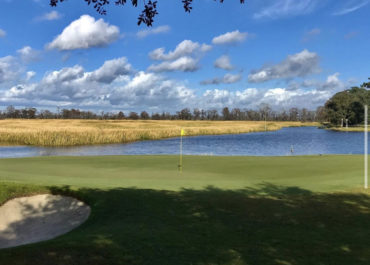

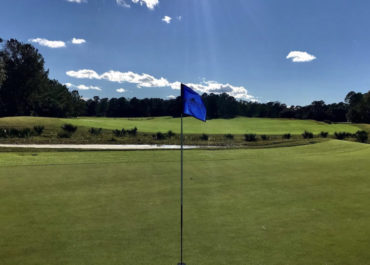
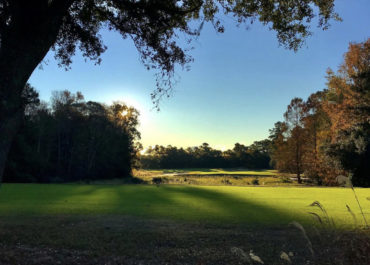
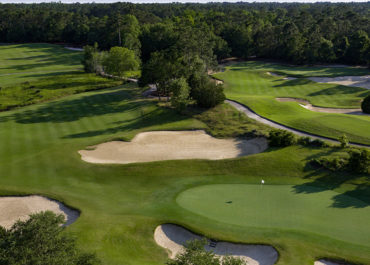
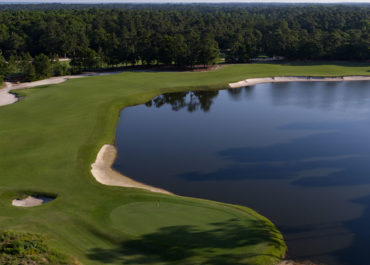
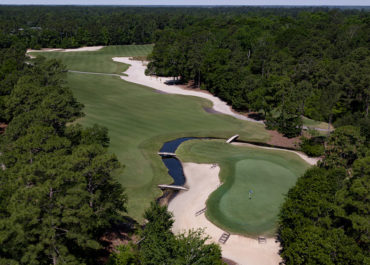
Caledonia Golf & Fish Club
Caledonia Golf & Fish Club opened in 1994. Built upon the site of a former working Southern rice plantation, it’s been described as having “18 signature holes,” with routings around majestic oaks, meandering streams and ever-invigorating flora and fauna.
From the drive to the clubhouse through a virtual tunnel of Live Oak and Spanish moss, to the views out over the salt marsh bordering the course, to the rolling design of the holes themselves, Caledonia is simply beautiful.
The Caledonia Plantation once consisted of 2,500 acres stretching from the Atlantic Ocean to the Waccamaw River. Over the years the estate was whittled down to just 152 acres. The plantation’s current owners bought it in 1971 and used the lush property as club for hunting and fishing club and built several small lodges.
Then, in the early 1990s, they decided to build a golf course while continuing to cater to outdoorsmen, which is why the course uses duck decoys as tee markers. Caledonia’s grounds are perfectly manicured; every shrub, flower petal and stairway of tabby, brick or railroad tie is precise.
When Strantz earned the commission to craft the course, the instructions were to preserve as much natural beauty as possible and move very little dirt. Given the architect’s “maverick” reputation, someone who didn’t always adhere to the traditional principles of golf course design, it was a tall task. But he repositioned less than 100,000 cubic yards of soil that, as a result, Caledonia became one of Strantz’s finest and least “controversial” courses.
There are just a few forced carries, and the mounding, while present, is generally subdued as Strantz allowed the trees and sand to determine the way golfers must play the course. There’s a gentle sculpting of the terrain, with an occasional accentuation to lend the setting flair.
As a par-70 and 6,526 yards from its back (pintail) set of tees, Caledonia will not overwhelm you with length. But from the tips the layout can be very tough, while offering risk-reward opportunities in spades. High-handicappers love the landscaping and four sets of tees, which provide versatility in play. But demanding pin placements mandate that the best golfers mind their Ps and Qs.
Caledonia Golf & Fish Club is a work of art, both in design and execution, laid upon a parcel with a rich history, Deep South accents, and visual cues of its former life. The place exudes personality from every pore. A round at Caledonia is truly a magnificent experience.
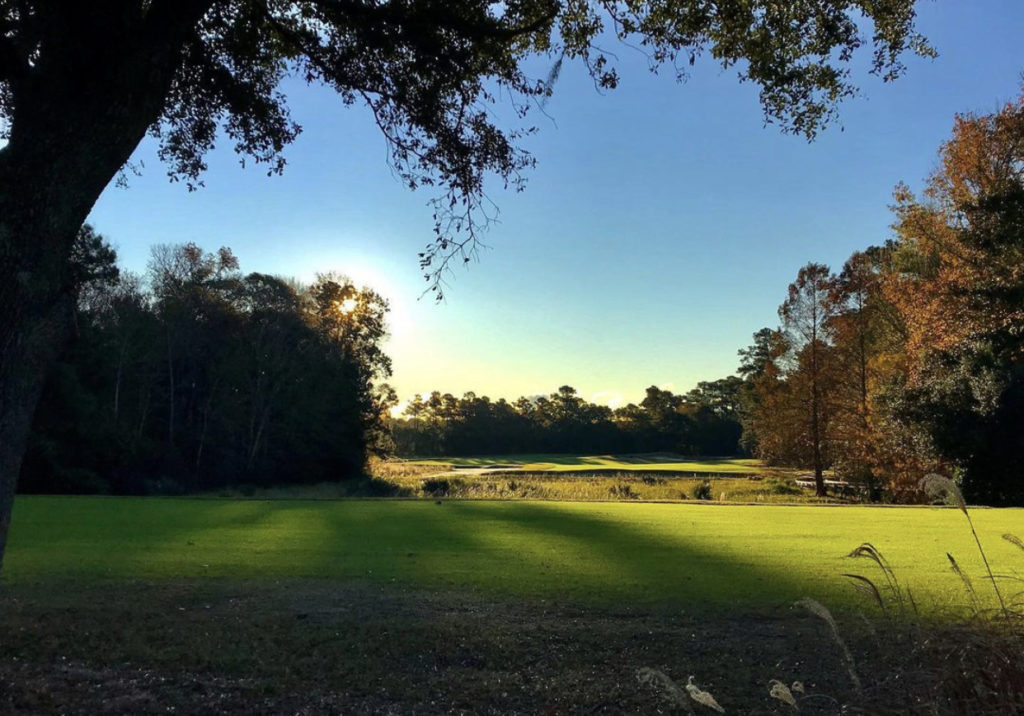
Caledonia
True Blue GC
True Blue GC opened right down the road in 1998 to a barrage of hype, and has, to its credit, managed to vindicate all the attention since being unveiled. Built on the site of an old indigo and rice plantation, the course features uncommon elevations and naturally rugged terrain. The rough, sandy areas were retained (all of them are waste bunkers by local rule) to provide striking contrast to the verdant greens, tees and fairways.
More exuberant in design than Caledonia, True Blue is representative of Strantz’s knack for crafting strong landforms. Mounds grow to impressive heights, bunkers abound and carries over water are everywhere. At True Blue everything is big, with expansive fairways and huge greens, some of whose pin placements can result in a three-club difference. It plays to a par 72 (37-35) and 7,126 yards from its back set of four tees.
The course’s par-3s tend to be extreme, with sprawling but narrow and topsy-turvy greens ringed by water and sand. The 190-yard third boasts an island green and a 58-yard-deep putting surface, and the 176-yard No. 7 features a two-tiered green where the upper level is about five feet higher than the lower.
On the 184-yard 11th your shot is all carry over a waste bunker to a sloping 40-yard-deep target. The 158-yard 14th has a tee box nearly 50 feet above a green that is placed artfully between a perilous waste area and round-inflating “pot” bunker.
Strantz’s uncanny ability to create individual experiences is revealed here. Despite the tough greens complexes at True Blue, the late designer gives players an opening if you have trouble keeping the ball in the air. His creative use of water and waste bunkers means this captivating layout stands out amid the other courses on the Grand Strand.
True Blue has been described as “Caledonia on steroids.” Soon after it opened, it earned another moniker — “Golf Heaven and Hell” — due to its toughness. Eventually, the course was revamped and slightly modulated by eliminating some of the blind shots.
True Blue is a very scenic track, with its back nine weaving through woodlands. You have to hit the ball straight — and long is better than short, but it’s still very playable and interesting. There is hardly a weak hole anywhere. It’s been said that golfers have strong feelings one way or the other about True Blue, but all seem to agree that it will never be forgotten.
Both tracks are part of the Waccamaw Golf Trail, a collection of a dozen of the finest golf courses along the Myrtle Beach Grand Strand’s Hammock Coast.
Repeat visitors to Myrtle Beach say they always take the time to tee it up at Caledonia and True Blue, then fill out the rest of their schedule. That’s how good these two courses are.
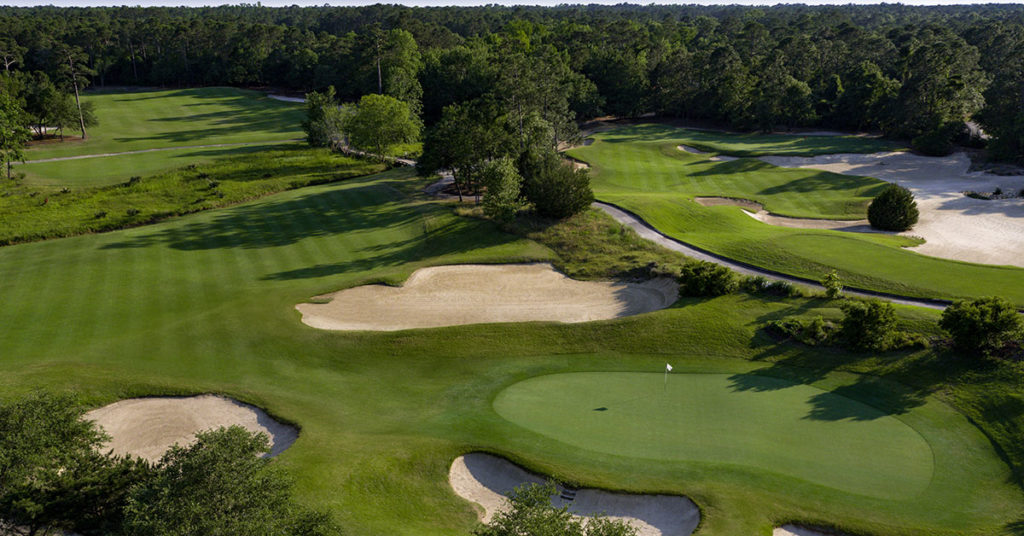
True Blue
Dunes Golf & Beach Club helped make Myrtle Beach a golf destination; Pawleys Plantation helped stoke the fire
It seems as if Myrtle Beach has been one of the nation’s top golf destinations forever, but that’s not really the case. Seventy years ago, very few players targeted South Carolina’s Lowcountry alongside the Atlantic as a must-play stop for golf; after all, most of the area’s 100-plus courses have been open for business only since the 1970s.
Two of the region’s best facilities, The Dunes Golf & Beach Club and Pawleys Plantation Golf & Country Club, are significant for the impact they had in bringing golf to the area while staying at the forefront of conversations about golf in this part of the world.
Work began on The Dunes Club in 1947 and it was ready for play as a nine-hole venue in 1949, making it the Grand Strand’s second golf facility. More than 70 years later, some 30 miles south on its eponymous island, Pawleys Plantation has maintained a high standard with a demanding but fair layout that utilizes every attribute that makes Myrtle Beach and its environs so ripe for great golf.
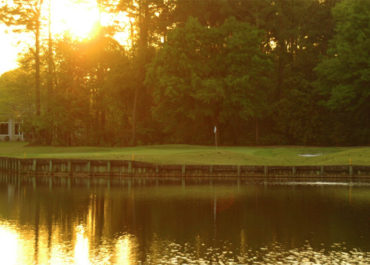
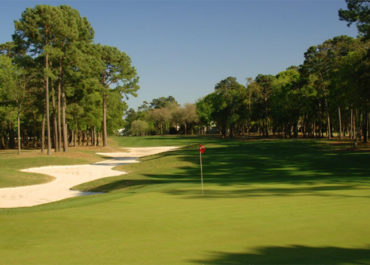
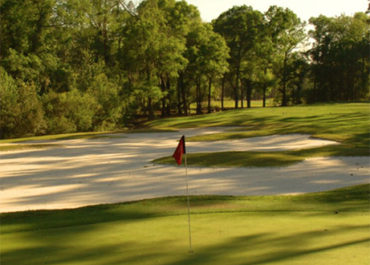

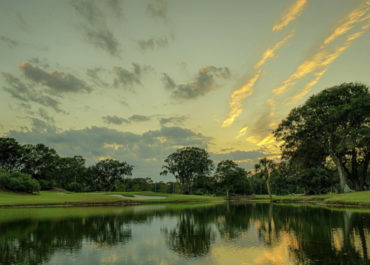
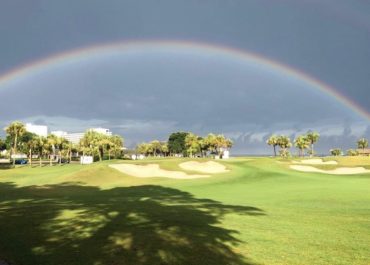


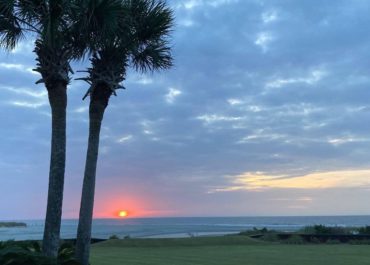
The Dunes Club
The Dunes Club has a classic pedigree thanks to a location along Singleton Swash overlooking the Atlantic Ocean and an inspired early-career routing by Robert Trent Jones, who began the project fresh off his collaboration with Bobby Jones at Atlanta’s Peachtree Golf Club. The Dunes Club was Jones’ first high-dollar project and its success placed him at the forefront of American golf course design.
In the 74 years since opening, The Dunes Club is firmly established as one of the top 100 in virtually every ranking of America’s top classic courses.
Jones changed his original design in 1976-77 and made more tweaks in 1992. In 2003, Rees Jones, RTJ’s son, restored all the greens to their original shape and made minor alterations to five greens to keep them consistent with the course’s initial design. The Dunes Club is a par-72 and 7,195 yards from its back set of five tees.
Much of its routing is through avenues defined by pines and mossy, live oak trees. The design is very traditional, with elevated greens and plenty of huge bunkers, and weaves among coastal woodlands then out to an ocean view on the ninth hole, and back around coastal marshlands on the home half.
Seven of the 10 par-4s at The Dunes Club play 425 yards or more from the tips. Many people consider the collection of par-5s here the best set found on any Jones-designed course.
Hole Nos. 11-13 comprises “Alligator Alley,” a stretch that might be the top three consecutive holes in the entire Myrtle Beach area. The Dunes Club‘s signature hole and perhaps the most renowned offering in the Grand Strand is the 590-yard 13th. Called “Waterloo,” it turns about 75 degrees to the right from tee to green and is bordered by Lake Singleton – home to a 20-foot alligator – on the right.
With its rolling fairways and large greens, The Dunes Club places a premium on shot-making. Hitting the ball to the correct spot in the fairway can generate extra roll and the preferred angle. It’s a bit of a cliché, but golfers will use every club in their bag here. This classic Jones layout certainly has stood the test of time and is a lasting legacy to one of the game’s great architects.
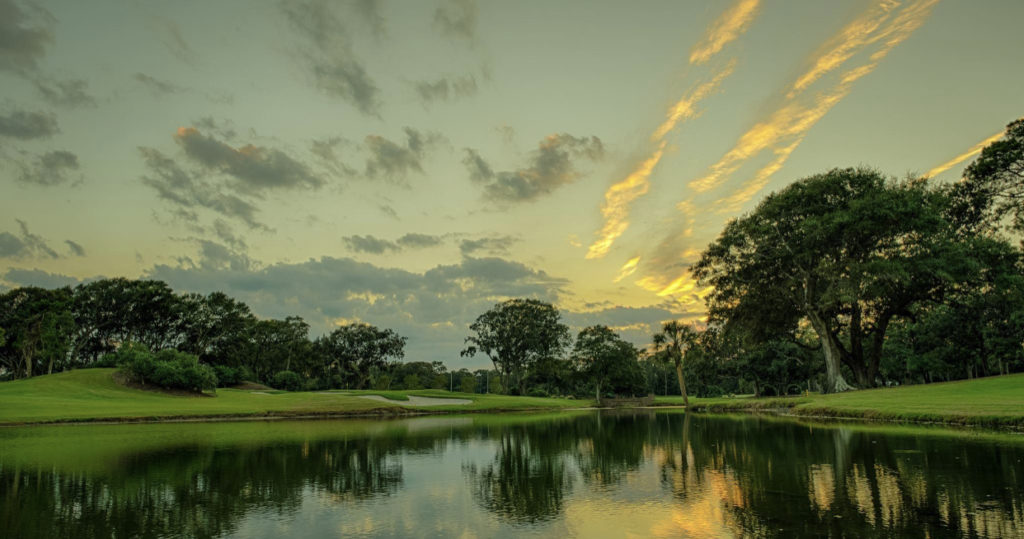
The Dunes Club
Pawleys Plantation Golf & Country Club
In October 1986, Jack Nicklaus stood in the middle of 582 acres on Pawleys Island and began designing a new golf course. He returned every few months, directing fairway shaping, aligning trees, determining the elevations and placement of greens and tees, incorporating all the subtle touches that play in golfers’ minds, again and again.
The tranquil surroundings of the marshes and creeks threading across the island and framed by 200-year-old moss-draped oaks are crucial to the experience Nicklaus created at Pawleys Plantation Golf & Country Club. “We used what was here, without forcing or changing what Mother Nature provided,” Nicklaus once said.
Every hole is tree-lined, unless it’s routed alongside the marsh. And the trees have grown since the course opened, so much so that players sometimes have to hit under these leafy canopies.
The par-72 Pawleys Plantation extends 7,026 yards from the tips. Nicklaus incorporated some unique touches, including a series of holes that use a wooden bulkhead to form the cart path as well as the tees at the 13th and 17th holes.
“Variety makes this course tremendously interesting to play,” Nicklaus noted. “Each of the 18 holes has a distinct strategy; green placement, water, tree lines, traps, mounds, split fairways and two holes sharing a spectacular double-green. You’ll have to think your way around the course, all the while, aware of how beautiful it is.”
Repeat players say it’s common to never have the same shot twice at Pawleys Plantation. The course has a striking finish, with six of the last seven holes involving marshes, and it has a Southern flair because of the live oaks. Five of the par-4s weigh in at least 432 yards.
The tees at the 145-yard 13th and 201-yard 17th abut each other and are accessed via a wooden bridge across a tidal marsh that must be carried to reach each bulkheaded green. On the 13th, a putting surface is on a peninsula half the size of the famed island green at TPC Sawgrass; this one slopes to the right-front.
These “all-or-nothing” shots are usually the first things anyone who has played Pawleys Plantation mentions.
Constantly changing scenery from marsh and wetlands to traditional tree-lined fairways keeps the guesswork going at Pawleys Plantation, a great combination of nature and man-made treatments. It was designed for the golfer who plays intelligently, and is a fun course with variety for all skill sets.
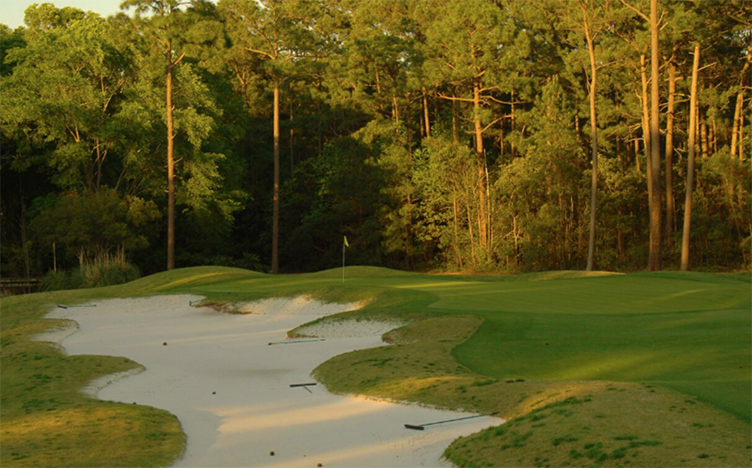
Pawleys Plantation

